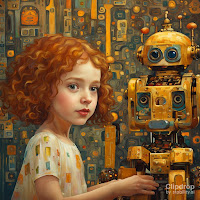The Art of Curiosity: Leveraging AI and the Aha!
Curiosity can be seen as a malleable skill that can be trained through teaching specific practices. One of the most important inquiry strategies to be trained is question-asking.
The study, GPT-3-driven pedagogical agents for training children’s curious question-asking skills, suggests that enhancing one’s curiosity-driven learning should focus on training the awareness of missing information and the appropriate inquiry strategies to compensate for it.
The study proposes a "prompt-based" method for generating pedagogical content using a large language model (LLM) that can automate the production of questions and answers. The LLM can be used to generate questions that are designed to pique the curiosity of children and encourage them to ask more questions. The study found that the output of the automated content generation was comparable to hand-generated content in terms of quality and effectiveness in promoting curiosity-driven learning.
However, the authors also note that having children use LLM-based systems without knowledge about their best practices and without developing critical thinking when interacting with them can be challenging. Therefore, the study suggests that pedagogical interventions should be developed to train children’s intellectual humility and critical thinking when using LLMs.
In a different context, François Pachet, in his work on The design of a musical flow machine, has introduced a related concept: the Surprise/Aha effect.
Enhancing Curiosity and Engagement: Both studies aim to enhance curiosity and engagement in their respective domains. François Pachet's work focuses on creating a musical flow machine that generates music with a sense of flow and coherence, capturing listeners' attention and fostering a state of engagement. Similarly, the study on training question-asking skills aims to stimulate curiosity and promote further inquiry in children by generating intriguing questions. Both approaches seek to create experiences that capture the interest of their respective audiences.
Surprise/Aha Effect as a Catalyst: The Surprise/Aha effect plays a role in both contexts. In François Pachet's work, the Surprise/Aha effect is a pivotal moment of unexpected discovery or insight in the music composition process. It can be a source of inspiration and creative breakthroughs. In the study on question-asking skills, generating questions that pique children's curiosity and prompt them to ask more questions can lead to moments of surprise or insight. The Surprise/Aha effect, whether in music or inquiry, can be a catalyst for deeper engagement and a source of motivation for continued exploration.
Flow as a Result of Engagement: Both studies relate to the concept of flow, albeit in different ways. François Pachet's work aims to create a musical flow machine that evokes a sense of immersive and enjoyable musical experience. The study on question-asking skills focuses on fostering curiosity-driven learning, which can lead to a state of flow in children. Both endeavors recognize the importance of engagement and the potential for achieving a state of flow through their respective approaches.
While the specific focus of these works differs, they share underlying principles related to capturing interest, fostering engagement, and leveraging moments of surprise or insight to enhance the overall experience. These connections highlight the broader application of concepts such as the Surprise/Aha effect and flow in various domains, including music composition and educational practices.



Comments